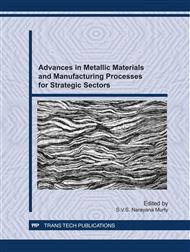p.575
p.581
p.588
p.594
p.603
p.608
p.614
p.620
p.626
Effect of Welding Processes (GTAW & EBW) and Solutionizing Temperature on Microfissuring Tendency in Inconel 718 Welds
Abstract:
Inconel 718 is widely used superalloy in the Indian space program for high temperature application. Some of the newer applications envisage use of this alloy in very critical high pressure oxygen carrying vessels. The alloy is frequently used in welded condition which requires extensive characterization of various types of welds viz Electron beam welding (EBW) and Gas tungsten arc welding (GTAW). In many cases the weldability of Inconel 718 is found to be limited by microfissuring phenomenon in the weld heat affected zone. Microfissures are fine intergranular cracks and their severity strongly depends on pre-weld solution treatment temperature (grain size), weld heat input and concentration of impurities (B, P and S) in the base metal. In the present work, a study was undertaken to compare the microfissuring tendency in EBW and GTAW processes using two pre-weld solution treatment temperatures. The samples were solution treated at 970°C and 1050°C to generate different grain sizes. Amount of heat input and cooling rate were calculated since they are known to affect the microfissuring and an effort was made to understand their role on the microfissuring. It was observed that microfissuring susceptibility is more at coarser grain size. Severity is more in EBW. The reasons for this phenomenon have been discussed in this paper correlating microfissuring with microstructures and other factors. Procedures to achieve minimal microfissuring during welding have also been brought out.
Info:
Periodical:
Pages:
603-607
Citation:
Online since:
January 2012
Price:
Сopyright:
© 2012 Trans Tech Publications Ltd. All Rights Reserved
Share:
Citation:


